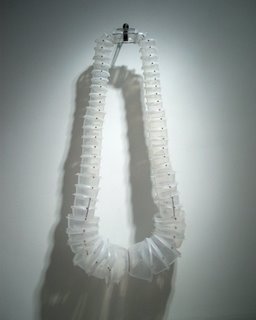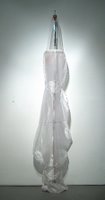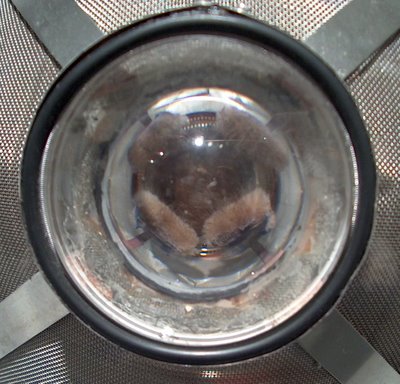Richard Keely "The Sift Series" at Simayspace
Sculptures by Richard Keely
Through April 26
Simayspace
Art Academy of San Diego
840 G. Street San Diego
619.231.3900
San Diego artist Richard Keely’s new exhibition, "The Sift Series", contains sculpture utilizing ordinary materials and every-day items. Challenging capitalistic society, Keely chooses his materials by searching for forms in thrift stores, 99 cent shops and other odd locations.

Pearl
Every object in the show is testament to his rejection of traditional ideas of “value” and the questioning of preciousness, the most hilarious being “Pearl”, created in 2006. Made from Rubbermaid food containers, brass boat fitting, springs, and cork, the giant “Bling” hangs on the wall, at once, a parody of good taste and popular culture.
There is another interesting aspect to Keely’s materials, alongside the plastic, there is an array of objects that might be found in an ambitious scientific experimentor’s lab: glass lenses, a bell jar, resin, strange nylon fabrics, gelatin, etc. This relationship with the biological sciences complements the naturalness of the forms.
The pieces in “The Sift Show” are unified through their organic forms and gestural, machine-like stylizing. The machine style comes from the liberal use of riveting and industrial looking materials. The work is gestural because like a good Persian rug, upon closer inspection, slight imperfections make it clear that each object is hand-made, not by machine.

A striking piece in the show is “Unititled” the nylon fabric creating a soothing, feminine form, riveted and topped with a bell jar.
Is there a literary reference in this work?
In Sylvia Plath’s novel "The Bell Jar", when Esther Greenwood examined her life, realized society's hypocritical conventions and the oppressive expectations of others, Esther could not keep the airless bell jar of depression and despair from descending over her while we the reader “watched” through the glass. Her descent into airlessness could be compared to how artspeak can be suffocating for an object. As an art object is examined closely, referenced, compared to other art and artists, grouped, sold, cataloged and given a place in contemporary history, is all the life-force sucked out of it? Does the critical and historical process cause suicide for a work of art? To an artist, a work of art is an intense labor of creation, a life brought about by a cosmically induced birth.
Was Richard Keely’s final attempt towards saving his shiny, beautiful, pristine, bell jar headed baby from the horror of cold critics and unfeeling historians to name it.... "Untitled"?
In his studio, Keely executes his work relying on an intuitive process to find the possibilities that could be brought into being. Buckminster Fuller called this process “cosmic fishing” and said that you always know when you’ve “caught one and brought it in.” For Richard Keely, meanings, ideas and plans not only get in the way of this process, but actually subvert his letting-go; his underlying consciousness must be free to flow. For Keely, his love and commitment for his art is in the materials and his time-intensive, careful fabrication process. The preciousness is in the creative process, where his hands are feeling, forming and fenestrating. The end result, the object, is for viewing pleasure of the audience.

Take a peek at this beauty...
Potential meaning is considered but not specific. According to Keely, the fundamental idea of his work is the inherent dichotomy of life, which he overlaps. The Chinese have a symbol for this exact idea, the yin/yang. The entire “Sift Series” is an amusing and also very touching experience of the dualism within the circle of life. Every piece in this show is rife with counter-meanings and each is worthy of pondering. Even the placement of the sculptures on the wall adds to this inherently provocative and absurdly seductive show.
In Plath’s “The Bell Jar”, Esther Greenberg replies to her boyfriend Buddy who has just called her neurotic, “If neurotic is wanting two mutually exclusive things at one and the same time, then I’m neurotic as hell. I’ll be flying back and forth between one mutually exclusive thing and another for the rest of my days.”
Richard Keely is letting us fly with him.
Through April 26
Simayspace
Art Academy of San Diego
840 G. Street San Diego
619.231.3900
San Diego artist Richard Keely’s new exhibition, "The Sift Series", contains sculpture utilizing ordinary materials and every-day items. Challenging capitalistic society, Keely chooses his materials by searching for forms in thrift stores, 99 cent shops and other odd locations.

Pearl
Every object in the show is testament to his rejection of traditional ideas of “value” and the questioning of preciousness, the most hilarious being “Pearl”, created in 2006. Made from Rubbermaid food containers, brass boat fitting, springs, and cork, the giant “Bling” hangs on the wall, at once, a parody of good taste and popular culture.
There is another interesting aspect to Keely’s materials, alongside the plastic, there is an array of objects that might be found in an ambitious scientific experimentor’s lab: glass lenses, a bell jar, resin, strange nylon fabrics, gelatin, etc. This relationship with the biological sciences complements the naturalness of the forms.
The pieces in “The Sift Show” are unified through their organic forms and gestural, machine-like stylizing. The machine style comes from the liberal use of riveting and industrial looking materials. The work is gestural because like a good Persian rug, upon closer inspection, slight imperfections make it clear that each object is hand-made, not by machine.

A striking piece in the show is “Unititled” the nylon fabric creating a soothing, feminine form, riveted and topped with a bell jar.
Is there a literary reference in this work?
In Sylvia Plath’s novel "The Bell Jar", when Esther Greenwood examined her life, realized society's hypocritical conventions and the oppressive expectations of others, Esther could not keep the airless bell jar of depression and despair from descending over her while we the reader “watched” through the glass. Her descent into airlessness could be compared to how artspeak can be suffocating for an object. As an art object is examined closely, referenced, compared to other art and artists, grouped, sold, cataloged and given a place in contemporary history, is all the life-force sucked out of it? Does the critical and historical process cause suicide for a work of art? To an artist, a work of art is an intense labor of creation, a life brought about by a cosmically induced birth.
Was Richard Keely’s final attempt towards saving his shiny, beautiful, pristine, bell jar headed baby from the horror of cold critics and unfeeling historians to name it.... "Untitled"?
In his studio, Keely executes his work relying on an intuitive process to find the possibilities that could be brought into being. Buckminster Fuller called this process “cosmic fishing” and said that you always know when you’ve “caught one and brought it in.” For Richard Keely, meanings, ideas and plans not only get in the way of this process, but actually subvert his letting-go; his underlying consciousness must be free to flow. For Keely, his love and commitment for his art is in the materials and his time-intensive, careful fabrication process. The preciousness is in the creative process, where his hands are feeling, forming and fenestrating. The end result, the object, is for viewing pleasure of the audience.

Take a peek at this beauty...
Potential meaning is considered but not specific. According to Keely, the fundamental idea of his work is the inherent dichotomy of life, which he overlaps. The Chinese have a symbol for this exact idea, the yin/yang. The entire “Sift Series” is an amusing and also very touching experience of the dualism within the circle of life. Every piece in this show is rife with counter-meanings and each is worthy of pondering. Even the placement of the sculptures on the wall adds to this inherently provocative and absurdly seductive show.
In Plath’s “The Bell Jar”, Esther Greenberg replies to her boyfriend Buddy who has just called her neurotic, “If neurotic is wanting two mutually exclusive things at one and the same time, then I’m neurotic as hell. I’ll be flying back and forth between one mutually exclusive thing and another for the rest of my days.”
Richard Keely is letting us fly with him.
